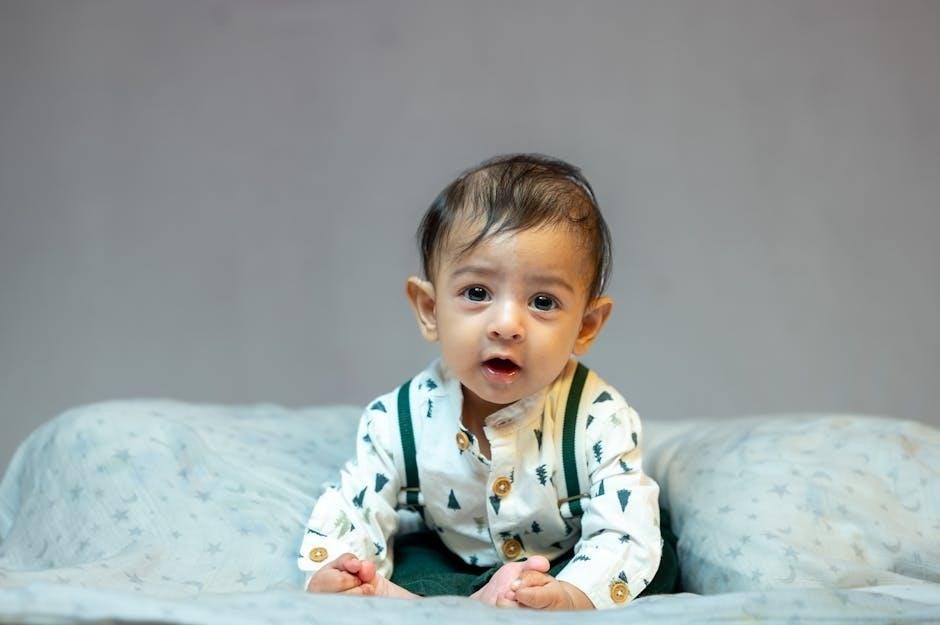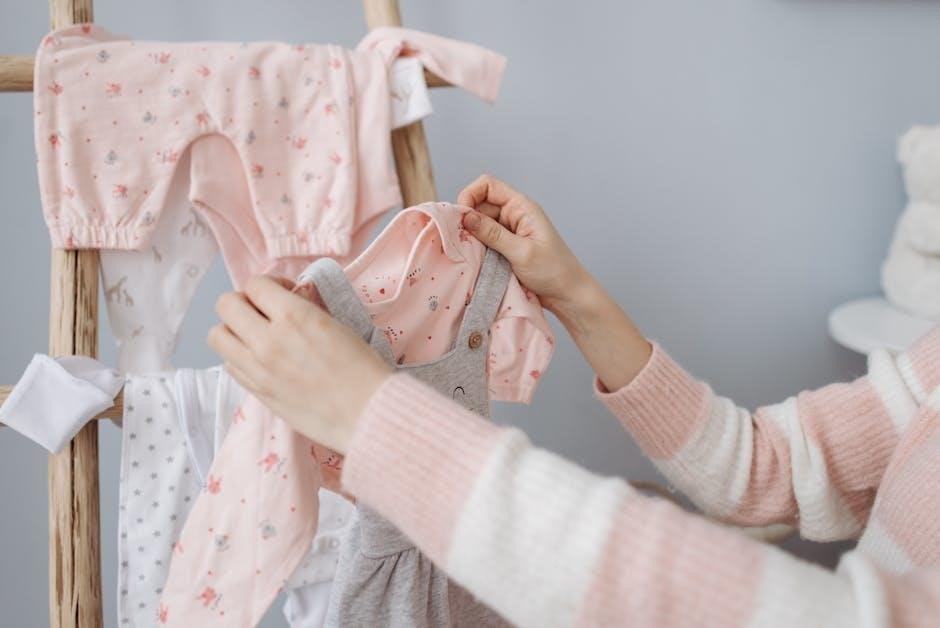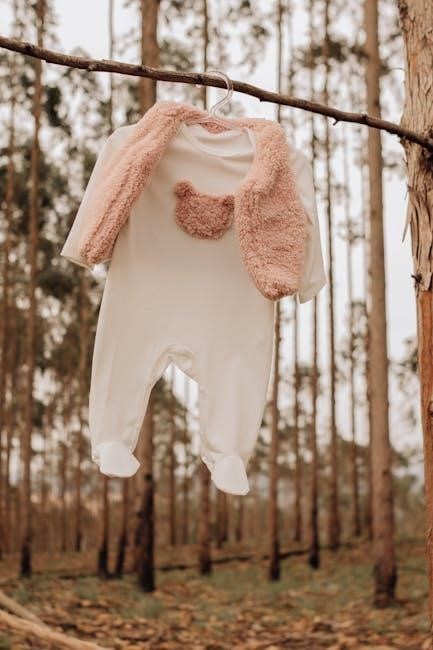Dressing your baby according to temperature ensures comfort and safety. The rule of thumb is to add one more layer than what you’d wear. Consider ambient temperature, activity levels, and your baby’s signs of comfort to guide your choices. This guide helps you navigate seasonal dressing with confidence, ensuring your baby stays cozy and healthy year-round.
Why Temperature Matters for Baby Clothing
Temperature plays a crucial role in dressing your baby, as their ability to regulate body heat is still developing. Overheating can lead to discomfort and potential health risks, while underheating may cause distress. Babies lose heat quickly due to their high metabolism and surface-to-weight ratio, making it essential to adjust clothing according to the environment. Monitoring ambient temperature ensures your baby stays comfortable and safe, preventing issues like hypothermia or heat stress. This awareness helps you make informed decisions about layering and fabric choices, promoting healthy growth and well-being.
Understanding the Rule of Thumb: Baby Wears One More Layer
A simple yet effective guideline for dressing your baby is to add one more layer than what you, as an adult, would wear comfortably. This rule helps prevent overheating and underheating, as babies lose heat faster due to their smaller size and higher metabolism. For example, if you’re wearing a t-shirt, your baby might need a onesie and a light sweater. This approach ensures your baby stays comfortable in various environments, whether indoors or outdoors, while maintaining a safe and healthy body temperature.

Dressing by Temperature Range
Dress your baby based on the temperature: cold (below 16°C/61°F), mild (16°C to 22°C/61°F to 72°F), and warm (above 22°C/72°F). Adjust layers accordingly for comfort and safety.
Cold Weather (Below 16°C/61°F): Layering for Warmth
For cold weather, start with a snug base layer like a cotton onesie. Add a middle layer such as a light sweater or fleece jacket for insulation. Use a thick, water-resistant coat or snowsuit as the outer layer, ensuring it has a hood to cover the head. Include accessories like a hat, secure scarf, gloves, and warm socks. Ensure clothes fit comfortably, neither too tight nor too loose. Monitor your baby’s comfort, adjusting layers as needed to prevent overheating or chilling.
Mild Weather (16°C to 22°C/61°F to 72°F): Balancing Comfort
In mild weather, dress your baby in breathable, lightweight layers. A cotton onesie or lightweight t-shirt is a great base. Add a thin sweater or light cardigan for cooler moments. Opt for soft, breathable fabrics like cotton to prevent overheating. Include lightweight pants or leggings for coverage. A lightweight hat and socks are optional but useful for outdoor outings. Ensure your baby feels comfortable by checking for signs of overheating or chilling throughout the day.
Warm Weather (Above 22°C/72°F): Lightweight and Breathable
In warm weather, prioritize lightweight, breathable fabrics like cotton or linen to keep your baby cool. Opt for short-sleeved onesies, simple t-shirts, or lightweight rompers. Avoid heavy layers and synthetic materials that trap heat. For outdoor outings, add a wide-brimmed sun hat and light, breathable cover-ups. Ensure your baby stays hydrated and monitor for signs of overheating, such as sweating or flushed skin. Dressing in layers allows you to adjust as needed, ensuring comfort and protection from the heat. Always check for comfort throughout the day.

Understanding Baby’s Comfort
Monitor your baby’s comfort by checking their neck, chest, and back for warmth or coolness. Look for signs like sweating, flushed skin, or shivering to ensure they’re neither too hot nor too cold.
Signs of Overheating: What to Look For
Signs of overheating include sweating, flushed skin, and restlessness. Check the back of your baby’s neck for excessive warmth. If their chest or upper back feels too hot, remove a layer. Look for rapid breathing or discomfort, as these indicate overheating. Avoid overdressing, especially in warm weather, to prevent discomfort and potential health risks. Always ensure your baby’s clothing breathes well and adjusts to their activity levels and surroundings.
Signs of Underheating: How to Identify
Signs of underheating include pale or blue-tinged skin, shivering, or feeling too cold to the touch. Check the chest or back for coolness. If your baby’s lower neck or upper back feels chilly, add a layer. Avoid letting your baby’s room become overly cold, as this can lead to discomfort. Monitor for lethargy or fussiness, which may indicate they’re too cold. Ensure they’re dressed warmly enough for the environment, especially in colder weather, to maintain proper body temperature and comfort.
How to Check Baby’s Temperature
To check your baby’s temperature, gently place your hand on the back of their neck or upper back. These areas provide a reliable gauge of their body heat. Avoid using their hands or feet, as they tend to feel cooler naturally. If their skin feels cool or clammy, they may need an extra layer. This simple method allows you to assess their comfort without special devices, ensuring they’re neither too hot nor too cold.
Layering Clothes for Optimal Temperature Regulation
Layering baby clothes is a versatile approach to adapt to changing temperatures. Use breathable fabrics like cotton, wool, or fleece, adjusting layers to maintain comfort and regulate body heat effectively.
Base Layers: Onesies and Sleepers
Base layers like onesies and sleepers provide essential comfort and warmth. Opt for breathable fabrics such as cotton or merino wool, which wick moisture and prevent overheating. These snug-fitting garments are perfect for colder months, ensuring skin stays dry and comfortable. For sleep, footed sleepers are ideal as they keep legs and feet warm without the need for separate socks. Always choose soft, hypoallergenic materials to protect sensitive skin and promote a restful sleep. This foundation is crucial for layering effectively in any season.
Middle Layers: Sweaters and Light Jackets
Middle layers like sweaters and light jackets add warmth without being overly heavy. Choose breathable fabrics such as cotton blends or fleece for optimal comfort. These layers are ideal for mild to cool temperatures and can be easily added or removed as needed. Look for soft, stretchy materials that allow freedom of movement while maintaining warmth. Pairing a snug base layer with a lightweight sweater or jacket creates a balanced outfit for everyday wear, ensuring your baby stays cozy and comfortable throughout the day.

Outer Layers: Coats and Snowsuits
Outer layers like coats and snowsuits are essential for colder temperatures, providing insulation and protection from wind and snow. Opt for waterproof and breathable materials, such as wool or synthetic insulation, to keep your baby dry and warm. Ensure a snug fit to retain body heat, and look for features like hoods and adjustable cuffs for added protection. These layers are crucial for outdoor adventures, ensuring your baby stays cozy and shielded from harsh weather conditions.

Sleepwear for Different Temperatures
Sleepwear should adapt to the season. Choose footed pajamas or sleep sacks for cold nights and lightweight, breathable fabrics for warmer weather. This ensures comfort year-round.
Winter Sleepwear: Footed Pajamas and Sleep Sacks
For colder months, opt for footed pajamas or sleep sacks to keep your baby warm and cozy. These garments provide full-body coverage, ensuring feet stay warm without the need for separate socks. Look for soft, breathable materials like cotton or fleece that trap heat without causing overheating. Sleep sacks are especially useful for active babies, allowing easy movement while maintaining warmth. Ensure the sleepwear fits snugly but not too tight, and avoid layers that could lead to overheating. Always check your baby’s comfort throughout the night to ensure they’re warm but not too hot.
Summer Sleepwear: Lightweight and Breathable Fabrics
For warmer weather, choose lightweight, breathable fabrics like cotton, bamboo, or muslin for your baby’s sleepwear. Opt for short-sleeved or sleeveless options to keep your baby cool and comfortable. Avoid heavy layers and instead use single-layer sleepers or simple onesies. These materials allow airflow and absorb moisture, preventing overheating. Ensure the sleepwear fits well, allowing easy movement. Check your baby’s comfort regularly, as rooms can vary in temperature. Lightweight sleepwear helps regulate body heat, ensuring a peaceful and safe sleep during summer months.

Choosing the Right Materials
Select fabrics like cotton, wool, or silk for natural breathability and comfort. Synthetic blends, such as fleece or polyester, offer warmth and durability, ideal for varying temperatures.
Natural Fibers: Cotton, Wool, and Silk
Cotton is soft, breathable, and ideal for mild to warm weather, keeping baby cool and comfortable. Wool provides excellent insulation for colder climates, regulating body temperature naturally. Silk, though less common, offers a smooth, hypoallergenic option for sensitive skin. These natural fibers are gentle on skin and promote airflow, reducing the risk of overheating. They are sustainable choices, supporting eco-friendly fashion and ensuring baby’s comfort across seasons.
Synthetic Fibers: Fleece and Polyester Blends
Synthetic fibers like fleece and polyester blends offer warmth, durability, and moisture-wicking properties, making them ideal for colder weather. Fleece traps heat while remaining lightweight and breathable, while polyester blends provide softness and easy care. These materials are often more affordable and quick-drying compared to natural fibers. They are perfect for active babies or outdoor activities, ensuring comfort without compromising on functionality. However, they should be layered with breathable base layers to prevent overheating and skin irritation.
Outdoor Considerations
Outdoor dressing requires adaptability to weather conditions. Ensure your baby’s comfort and safety with appropriate accessories like hats, gloves, and scarves for cold weather, and sun hats for warmth.
Winter Outdoor Dressing: Hats, Gloves, and Scarves
For winter outings, accessorize your baby with hats, gloves, and scarves to retain body heat. Choose breathable, moisture-wicking fabrics like wool or fleece. Ensure a snug fit to prevent heat loss. Avoid loose scarves that may pose choking hazards. Opt for mittens over gloves for better warmth. Check for signs of discomfort or overheating, such as sweating or fussiness. Dressing in layers allows easy adjustments. Ensure visibility with bright colors or reflective details for safety in low-light conditions.
Summer Outdoor Dressing: Sun Hats and Light Covers
Protect your baby from summer heat and sun exposure with lightweight, breathable clothing. Opt for sun hats with UV protection and a wide brim to shield their face and neck. Use light, loose-fitting covers or swaddle blankets to prevent overheating while outdoors. Choose fabrics like cotton for breathability. Avoid heavy layers and ensure your baby stays hydrated. Check for signs of overheating, such as sweating or flushed skin, and adjust clothing as needed to maintain comfort in warm weather.
Monitoring and Adjusting
Regularly monitor your baby’s comfort by checking for signs of overheating or underheating. Adjust layers as needed to maintain a stable body temperature, ensuring optimal comfort and safety.
Checking for Comfort Throughout the Day
Check your baby’s comfort by gently feeling the nape of their neck or upper back. If they feel too warm, remove a layer. Look for signs of overheating, such as sweating or flushed cheeks. If your baby feels chilly or shivers, add a layer. Regularly monitor their temperature, especially during naps or outings, and adjust clothing as needed. This ensures your baby stays comfortable and safe throughout the day, regardless of changing conditions.
Adjusting Layers Based on Activity Levels
Adjust your baby’s clothing based on their activity level. During active play, remove layers to prevent overheating, while during rest or naps, add layers for warmth. Monitor their comfort by feeling the nape of their neck or back. If they feel too warm or cool, make adjustments. This ensures their temperature stays balanced, whether they’re moving around or resting. Regular checks help maintain comfort and prevent discomfort caused by changing activity levels throughout the day.
Dressing your baby by temperature is a practical guide to ensuring their comfort and safety. Layering, material choices, and regular checks are key to maintaining optimal comfort.
Final Tips for Dressing Your Baby by Temperature
Always check your baby’s comfort by feeling their neck or back. Use breathable fabrics like cotton and layer clothing according to the temperature. Avoid overcomplicating outfits—simplicity ensures ease of movement. Monitor your baby’s responses to heat and cold, adjusting layers as needed. Dress according to the room temperature, not just outdoor conditions. Remember, your baby’s comfort is key to their happiness and health.
